Shade-loving plants transform fence lines into vibrant gardens where other plants struggle. They’ll thrive in areas with limited sunlight, creating privacy and vertical interest while maximizing your limited space. These plants reduce heat absorption, improving home energy efficiency, and attract specialized pollinators that prefer cooler environments. By layering plants of varying heights and textures, you’ll create stunning visual displays that evolve throughout the seasons. Discover how these resilient beauties can turn challenging spots into your garden’s highlight.
11 Second-Level Headings for “Why Choose Shade-Loving Plants For Fence Gardens?”
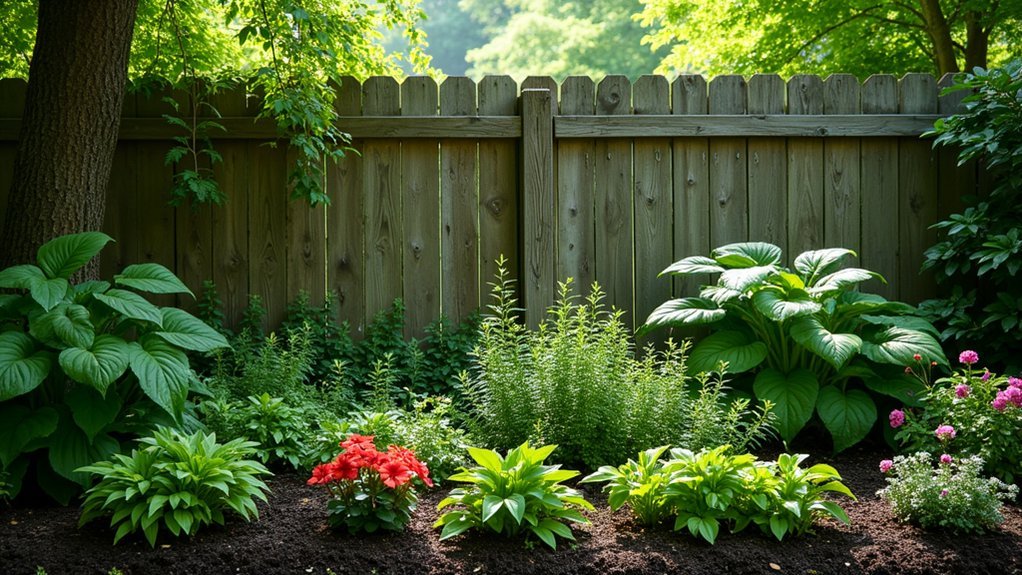
When planning your fence garden, selecting shade-loving plants offers numerous advantages that sun-hungry varieties simply can’t match. These specialized plants thrive in limited sunlight conditions created by your fence, turning problematic shady spots into lush, vibrant spaces.
Shade-loving plants are typically low-maintenance, requiring less watering and attention than their sun-demanding counterparts. They’ll enhance aesthetic appeal throughout the seasons with varied textures and colors that bring life to otherwise overlooked areas.
Consider incorporating native shade plants that support local wildlife while naturally adapting to your region’s climate conditions. Their established root systems help prevent soil erosion along fence lines, creating a stable, sustainable garden environment.
You’ll enjoy both beauty and ecological benefits while making the most of those challenging shaded spaces.
Understanding Shade Conditions Along Fence Lines
Why do so many gardeners struggle with fence plantings? The answer often lies in misunderstanding the unique shade conditions these areas present.
Fence gardens typically experience varying levels of shade throughout the day, creating microclimates that demand specific plant selections.
Before establishing your shade garden, spend time observing how light moves across your fence line. Note when it receives direct sunlight versus dappled light or deep shade. These patterns change seasonally, affecting which shade-loving plants will thrive in each section.
The type of shade matters too—morning shade differs from afternoon shade in intensity and temperature. Your fence might create deep shade in some spots while allowing filtered light in others.
Understanding shade variations along your fence empowers you to select plants that will flourish rather than merely survive.
Benefits of Vertical Shade Gardens as Natural Boundaries
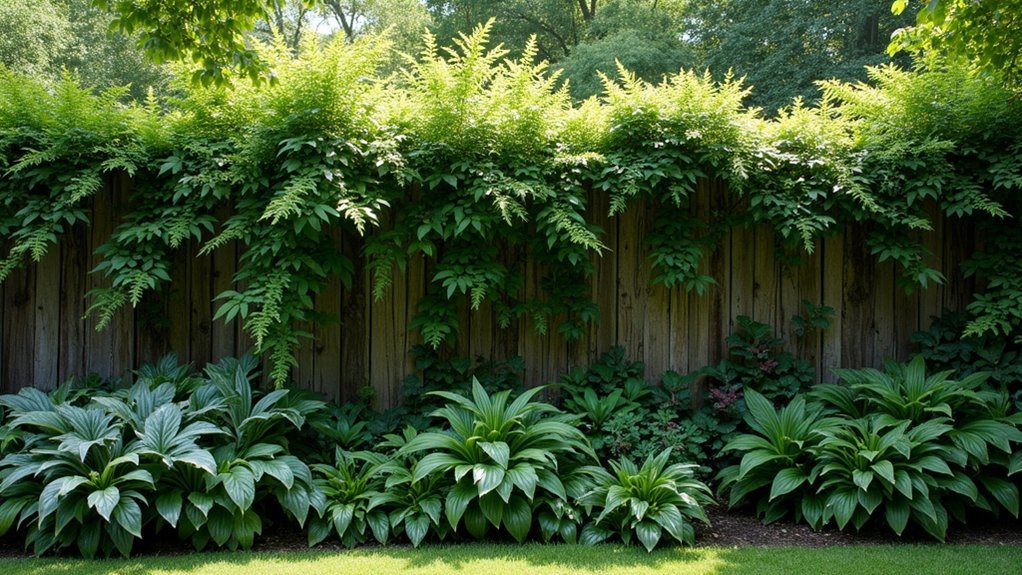
With your fence’s shade patterns now mapped out, you’re ready to transform that challenging boundary into a vibrant vertical garden.
Vertical shade gardens maximize limited space while creating lush, natural screens that enhance privacy and visual appeal in your outdoor spaces.
Vertical gardens turn boundary constraints into opportunities, transforming bland barriers into living, privacy-enhancing green canvases.
By selecting diverse shade-loving plants like ferns and hostas, you’ll introduce varying textures and colors that soften stark fence lines.
These gardens offer practical benefits beyond aesthetics—they reduce heat absorption around your home, improving energy efficiency during summer months.
Incorporating climbing vines and shade-tolerant shrubs promotes biodiversity by attracting pollinators and beneficial insects.
For year-round interest, mix flowering and foliage plants to guarantee seasonal color shifts.
Your fence boundary becomes more than a property divider—it transforms into a living ecosystem that brings nature closer while defining your outdoor sanctuary.
Top Shade-Tolerant Climbers for Fence Integration
Although many gardeners assume vertical spaces require full sun, shade-tolerant climbers offer spectacular solutions for transforming dim fence lines into living tapestries.
You’ll find options like climbing hydrangea, with its stunning white blooms and textured bark, perfect for adding vertical interest to fence gardens with limited sunlight.
Virginia creeper thrives in shaded areas, providing dense coverage and brilliant fall color.
For aromatic additions, consider hops as a fast-growing shade-tolerant vine, or sweet autumn clematis, which produces fragrant white flowers in late summer despite growing in partial shade.
- Create multi-season interest by combining climbers with different blooming periods
- Use varying textures and leaf patterns to add depth to your shade garden design
- Consider growth rates when planning—some shade-loving climbers establish quickly while others develop more gradually
Creating Year-Round Interest With Shade Foliage Textures
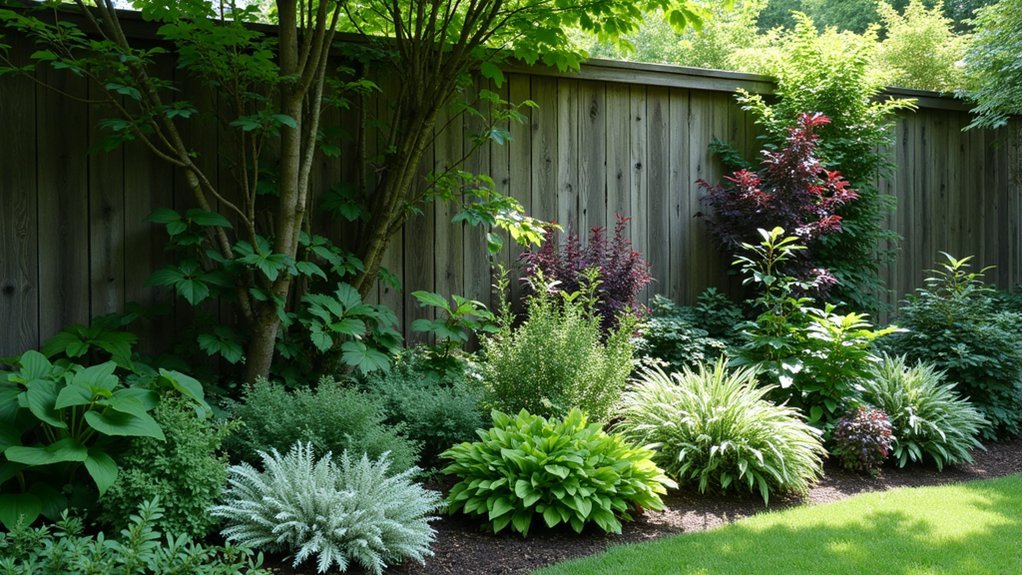
Texture becomes your secret weapon when designing shade gardens along fence lines. By selecting shade-loving perennials with diverse foliage textures, you’ll create visual interest that persists throughout all seasons. Mix broad-leaved plants like hostas and ligularia with the delicate fronds of ferns and astilbe for a dynamic, layered effect.
| Season | Plant Suggestion | Texture Contribution |
|---|---|---|
| Spring | Hellebores | Leathery, glossy leaves |
| Summer | Coral Bells | Ruffled, colorful foliage |
| Fall | Japanese Forest Grass | Fine, arching blades |
Don’t overlook groundcovers like Lamium that provide a lush green carpet contrasting beautifully with taller specimens. The variety of foliage shapes, sizes, and colors—from burgundy to lime green—ensures your shade gardens maintain seasonal color and visual appeal, even when flowers aren’t present.
Low-Maintenance Shade Plants for Busy Gardeners
Busy gardeners seeking beauty without the burden of constant maintenance will find shade gardens particularly rewarding. Resilient options like Hostas and Japanese Forest Grass thrive in minimal sunlight while requiring just occasional watering and periodic pruning.
Nature’s low-maintenance masterpiece awaits in the shadows, where resilient plants flourish with minimal human intervention.
You’ll appreciate shade-loving plants such as Astilbe and Coral Bells, which return year after year without replanting.
- Ground covers like Deadnettle and Lungwort naturally suppress weeds, eliminating hours of tedious garden maintenance.
- Perennial shade plants establish stronger root systems over time, becoming more drought-resistant and self-sufficient.
- Diverse textures from plants like Hellebores and Foamflowers create visual interest that changes seasonally without additional effort.
Designing Layered Fence Plantings in Limited Light
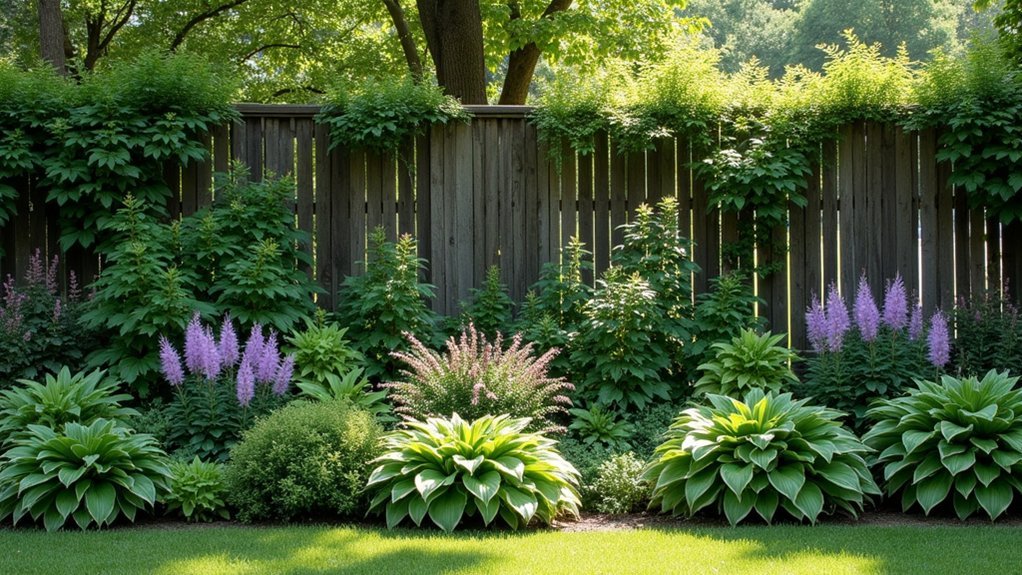
When creating a garden along a shaded fence, thoughtful layering transforms an ordinary boundary into a lush vertical showcase. Position taller plants like hydrangeas or dogwoods at the back, ensuring they receive adequate light for their partial shade requirements.
| Layer | Plant Options | Light Needs |
|---|---|---|
| Back | Hydrangeas, Dogwoods | Partial shade to full sun |
| Middle | Ferns, Coral Bells | Partial to full shade |
| Front | Deadnettle, Vinca Minor | Shade tolerant |
For the middle layer, incorporate diverse shade plants with varied textures. Groundcover options in the front layer help suppress weeds while maintaining soil moisture. Enhance your design with seasonal bloomers like bleeding hearts or astilbe for continuous interest. Remember proper spacing based on mature sizes to prevent overcrowding and promote healthy air circulation in your layered fence plantings.
Soil Preparation for Successful Shade Fence Gardens
Testing your soil’s pH (ideally between 6.0-7.0) is the essential first step before planting shade-loving species along your fence line.
You’ll need to incorporate generous layers of compost or well-rotted manure to enrich the typically challenging soil conditions found in shaded areas.
Installing proper drainage solutions, such as raising beds or adding coarse materials like perlite, will prevent the waterlogging that can occur in shade gardens where evaporation happens more slowly.
Test Soil Ph First
Before planting anything along your fence line, a critical first step involves checking your soil’s pH level to guarantee success with shade-loving plants. Most shade-lovers thrive in slightly acidic to neutral soil (pH 6.0-7.0), ensuring the best nutrient uptake.
Collect multiple samples from your fence garden area to get an accurate representation of your soil composition. You can use an inexpensive home testing kit or send samples to a professional service for more detailed analysis.
Based on results, amend your soil with lime to raise pH or sulfur to lower it, creating the ideal environment for your chosen plants.
- Well-drained soil prevents root rot in moisture-sensitive shade plants
- Regular pH monitoring helps maintain plant health as environmental factors change
- Different sections of your fence may require different amendments depending on sun exposure
Layer Organic Matter
Successful shade fence gardens begin with rich, layered organic matter that transforms your soil structure and nutrient profile. By incorporating compost and well-rotted manure, you’ll create an ideal environment where shade-loving plants can thrive despite limited sunlight.
This organic foundation improves moisture retention in shaded areas, where evaporation naturally occurs more slowly. As these materials decompose, they stimulate microbial activity, creating a living soil ecosystem that supports healthier root development.
You’ll notice improved root penetration as the organic matter prevents soil compaction in these typically dense, cool areas.
Don’t add organic matter just once—replenish it throughout the growing season to maintain soil fertility. This consistent soil enrichment guarantees your shade-loving plants receive continuous nutrition, helping them flourish even in challenging fence garden conditions.
Improve Drainage Solutions
Beyond organic richness, your shade fence garden’s success hinges greatly on proper water movement through the soil. When preparing soil for shade-loving plants, focus on creating a balance between drainage and moisture retention.
For heavy clay soils, incorporate coarse sand or perlite to prevent waterlogging that can damage delicate root systems. Consider raised beds or soil mounding as effective drainage solutions, especially in chronically damp areas.
- Conduct a soil test before planting to identify specific drainage issues and pH levels that might affect your shade garden’s performance
- Mix organic matter thoroughly with existing soil to create pockets for air circulation while maintaining necessary moisture
- Create slight slopes or channels within your garden bed to direct excess water away from plant roots during heavy rainfall
Combining Shade Plants for Maximum Visual Impact
While many gardeners overlook shaded fence areas as challenging spots, they actually present wonderful opportunities for creating dynamic visual displays. By pairing shade-loving plants with complementary characteristics, you’ll transform these spaces into stunning focal points.
Layer plants of varying heights, positioning tall Foxglove behind shorter Deadnettle to create vertical dimension that draws the eye upward along your fence gardens. Incorporate diverse foliage colors by mixing vibrant Coral Bells with lush Hostas for depth and interest.
Strategic layering transforms fence gardens from forgotten shadows to striking visual journeys that capture attention and imagination.
Don’t forget to include seasonal bloomers like summer-flowering Astilbe and spring-blooming Foamflower to guarantee continuous color throughout the growing season.
For a complete solution, combine ground covers like Vinca Minor with taller perennials—this suppresses weeds while providing a lush backdrop that enhances your fence garden’s visual impact.
Wildlife Benefits of Shade-Tolerant Fence Plantings
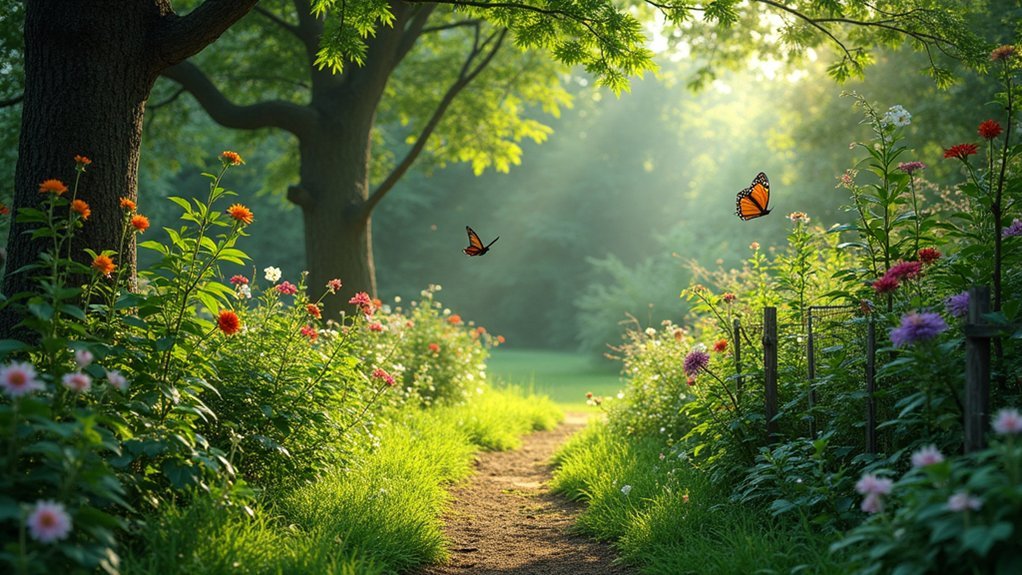
Your shaded fence line can become a thriving wildlife sanctuary when planted with appropriate shade-tolerant species.
Native plants that flourish in low-light conditions create essential habitat corridors that connect fragmented ecosystems. When you incorporate ferns, wildflowers, and woody shrubs along your fence, you’re establishing a microhabitat that supports local biodiversity.
- Shade-tolerant native plants attract specialized pollinators that depend on cooler, protected environments to complete their life cycles.
- Dense, layered plantings provide nesting sites, protective cover, and food sources for birds and small mammals throughout changing seasons.
- Diverse root systems of shade plants improve soil structure, supporting earthworms and beneficial microorganisms that enrich your garden’s ecosystem.
These wildlife benefits transform your fence line from a simple boundary into a living ecosystem supporting nature right in your backyard.
Watering and Care Tips for Vertical Shade Gardens
Your vertical shade garden can considerably reduce water consumption compared to sun-exposed areas, with plants requiring less frequent irrigation once established.
Adjust your watering schedule seasonally, providing deeper, less frequent watering during summer months and scaling back during cooler, wetter periods when natural rainfall might suffice.
You’ll maximize moisture retention by watering in the early morning, allowing foliage to dry before evening and preventing fungal issues common in shaded environments.
Water Conservation Benefits
Because shade-loving plants naturally require less moisture than their sun-dwelling counterparts, they’re perfect allies in water conservation efforts for vertical fence gardens.
By choosing varieties like ferns and hostas, you’ll take advantage of reduced evaporation rates, keeping soil moisture levels stable with minimal intervention.
Add a layer of mulch around your shade-loving plants to further enhance water retention in your vertical gardens.
Coupled with efficient drip irrigation systems or self-watering containers, you’ll create an eco-friendly growing environment that conserves this precious resource.
- Monitor soil moisture regularly to establish ideal watering schedules tailored to your specific plants
- Combine multiple water-saving strategies for maximum conservation benefits
- Save time and resources while still maintaining lush, healthy fence gardens year-round
Seasonal Moisture Needs
While shade-loving plants generally need less water than sun-seekers, their moisture requirements fluctuate considerably throughout the year.
During warmer months, you’ll need to monitor soil moisture levels more frequently, ensuring the soil remains consistently moist without becoming waterlogged.
Adjust your watering frequency based on seasonal rainfall and temperature changes. In spring and fall, you might water less often, while summer may demand more attention to moisture needs.
Apply organic mulch around your vertical garden’s base to conserve moisture, regulate soil temperature, and suppress weeds.
Consider installing a drip irrigation system for your fence garden—it delivers water directly to plant roots, reducing evaporation and minimizing fungal disease risks common in shaded environments.
This approach is particularly effective for vertical arrangements where water distribution can be challenging.
Frequently Asked Questions
Why Do Some Plants Do Better in Shade?
Some plants do better in shade because they’ve adapted to thrive with less sunlight. They’ve developed larger leaves for better light absorption, efficient nutrient storage, and shallower root systems that avoid competition with trees.
What Are the Benefits of Shade in the Garden?
Shade in your garden conserves water, reduces plant stress, creates cool retreats, minimizes weeds, and supports diverse plant species. You’ll enjoy lower maintenance while cultivating unique shade-loving perennials that add beautiful texture to your landscape.
What Is the Difference Between Sun-Loving and Shade-Loving Plants?
Sun-loving plants need at least 6 hours of direct sunlight and have deeper roots, while shade-loving plants thrive with less than 4 hours of light and typically feature broader leaves and shallower root systems.
What Is the Best Plant for a Fence?
For fence planting, you’ll find climbing hydrangea works best. It’s versatile, thrives in sun or shade, clings naturally without support, and offers beautiful white blooms. It’s low-maintenance once established and long-lasting.
In Summary
By choosing shade-loving plants for your fence garden, you’ll transform challenging spaces into vibrant, low-maintenance sanctuaries. You’ve learned how these specialized plants thrive where others fail, creating privacy while supporting local wildlife. Remember, with proper soil preparation and thoughtful combinations, your fence line can showcase stunning foliage textures year-round. Now you’re ready to turn those shaded boundaries into the most distinctive feature of your landscape.

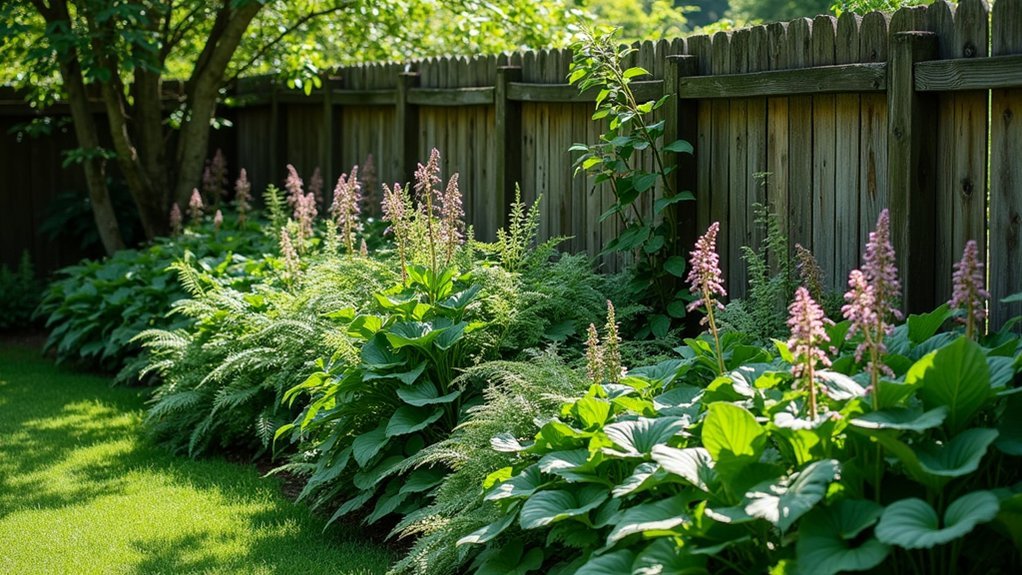



Leave a Reply